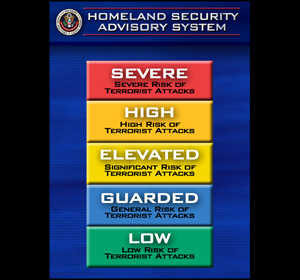U.S. on "Yellow" (Elevated) Security Threat Level For Foreseeable Future; We Post Homeland Security Statement On New Threat Advisory System
 (March 12, 2002) -- The White House Office of Homeland Security has released a color coded system to disseminate information to federal, state, local officials and the public regarding the level of risk of terrorist attacks. The system, ranking threat levels and including protective measures (detailed below) that are supposed to be taken by government and the private sector to reduce vulnerabilities. are green (low), guarded (blue), yellow (elevated), orange (high) and red (severe). The system is being proposed for implementation after a public comment period. We post verbatim the statement issued by the White House Office of Homeland Security below. Speaking on CBS "This Morning," Homeland Security Dir. Tom Ridge indicated the nation is currently on "yellow" alert level and will likely remain so for the foreseeable future. Based on the color coded descriptions, this would indicate: "Significant risk of terrorist attacks. In addition to the previously outlined [lower color coded] Protective Measures, the following may be applied: Increasing surveillance of critical locations; Coordinating emergency plans with nearby jurisdictions; Assessing further refinement of Protective Measures within the context of the current threat information; and Implementing, as appropriate, contingency and emergency response." [begin Homeland Security office text] The Homeland Security Advisory System will provide a comprehensive and effective means to disseminate information regarding the risk of terrorist attacks to Federal, State, and local authorities and to the American people. As part of a series of initiatives to improve coordination and communication among all levels of government and the American public in the fight against terrorism, President Bush signed Homeland Security Presidential Directive 3, creating the Homeland Security Advisory System (HSAS). The advisory system will be the foundation for building a comprehensive and effective communications structure for the dissemination of information regarding the risk of terrorist attacks to all levels of government and the American people. The Attorney General will be responsible for developing, implementing and managing the system. In conjunction with the development of this new system, the Attorney General will open a 45-day comment period in order to seek the views of officials at all levels of government, law enforcement and the American public. Ninety days after the conclusion of the comment period, the Attorney General in coordination with the Director of the Office of Homeland Security -- will present a final Homeland Security Advisory System to the President for approval. The Homeland Security Advisory System will provide the following: National framework for Federal, State, and local governments, private industry and the public. There are many federal alert systems in our country -- each tailored and unique to different sectors of our society: transportation , defense, agriculture, and weather, for example. These alert systems fill vital and specific requirements for a variety of situations in both the commercial and government sectors. The Homeland Security Advisory System will provide a national framework for these systems, allowing government officials and citizens to communicate the nature and degree of terrorist threats. This advisory system characterizes appropriate levels of vigilance, preparedness and readiness in a series of graduated Threat Conditions. The Protective Measures that correspond to each Threat Condition will help the government and citizens decide what action they take to help counter and respond to terrorist activity. Based on the threat level, Federal agencies will implement appropriate Protective Measures. States and localities will be encouraged to adopt compatible systems. Factors for assignment of Threat Conditions. The Homeland Security Advisory System will provide a framework for the Attorney General, in consultation with the Director of the Office of Homeland Security, to assign Threat Conditions, which can apply nationally, regionally, by sector or to a potential target. Cabinet Secretaries and other members of the Homeland Security Council will be consulted as appropriate. A variety of factors may be used to assess the threat. Among these: Unified system for public announcements. Public announcements of threat advisories and alerts help deter terrorist activity, notify law enforcement and State and local government officials of threats, inform the public about government preparations, and provide them with the information necessary to respond to the threat. State and local officials will be informed in advance of national threat advisories when possible. The Attorney General will develop a system for conveying relevant information to Federal, State, and local officials, and the private sector expeditiously. Heightened Threat Conditions can be declared for the entire nation, or for a specific geographic area, functional or industrial sector. Changes in assigned Threat Conditions will be made when necessary. A tool to combat terrorism. Threat Conditions characterize the risk of terrorist attack. Protective Measures are the steps that will be taken by government and the private sector to reduce vulnerabilities. The HSAS establishes five Threat Conditions with associated suggested Protective Measures: Low risk of terrorist attacks. The following Protective Measures may be applied: Refining and exercising preplanned Protective Measures Ensuring personnel receive training on HSAS, departmental, or agency-specific Protective Measures; and Regularly assessing facilities for vulnerabilities and taking measures to reduce them. Guarded Condition -- Blue General risk of terrorist attack. In addition to the previously outlined Protective Measures, the following may be applied: Checking communications with designated emergency response or command locations; Reviewing and updating emergency response procedures; and Providing the public with necessary information. Elevated Condition -- Yellow Significant risk of terrorist attacks. In addition to the previously outlined Protective Measures, the following may be applied: Increasing surveillance of critical locations; Coordinating emergency plans with nearby jurisdictions; Assessing further refinement of Protective Measures within the context of the current threat information; and Implementing, as appropriate, contingency and emergency response plans. High Condition -- Orange High risk of terrorist attacks. In addition to the previously outlined Protective Measures, the following may be applied: Coordinating necessary security efforts with armed forces or law enforcement agencies; Taking additional precaution at public events; Preparing to work at an alternate site or with a dispersed workforce; and Restricting access to essential personnel only. Severe Condition -- Red Severe risk of terrorist attacks. In addition to the previously outlined Protective Measures, the following may be applied: Assigning emergency response personnel and pre-positioning specially trained teams; Monitoring, redirecting or constraining transportation systems; Closing public and government facilities; and Increasing or redirecting personnel to address critical emergency needs. Written comments may be sent to: Director, Federal Bureau of Investigation, Homeland Security Advisory System, Room 7222, 935 Pennsylvania Avenue, N.W. Washington, D.C. 20535. Comments may also be submitted electronically to: HSAScomments@fbi.gov |



